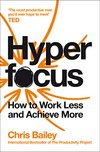
Saved by CodeMacLife and
Hyperfocus: How to Work Less to Achieve More

Saved by CodeMacLife and
you are what you pay attention to. Attention is finite and is the most valuable ingredient you have to live a good life
Scatterfocus lets us work with greater intention because our mind automatically contrasts the future we desire against the present we need to change to make that future a reality.
goals need plans, ideally plans that include when, where, and which kind of action to move towards the goal.”
you’ll notice that your most necessary and purposeful tasks can’t be done out of habit.4 This is exactly what makes these tasks so productive. You
As author Malcolm Gladwell wrote: “Practice isn’t the thing you do once you’re good. It’s the thing you do that makes you good.”
We’ve crafted the world around us to cater to these cravings for novel, pleasurable, and threatening objects of attention. Consider this the next time you turn on the TV, open YouTube, read a news website, or check social media—these outlets provide a steady fix of all three.
Novel objects of attention threaten to invade your attentional space and prevent you from focusing completely on any one thing.
when it comes to solving creative problems, the less control we have over our attention, the better.
One of my favorite weekly routines is a focus ritual, which I schedule for every Sunday evening or Monday morning to plan my week. During it I decide on my three weekly intentions and assess how much I’ll need to hyperfocus and scatterfocus in the days ahead.